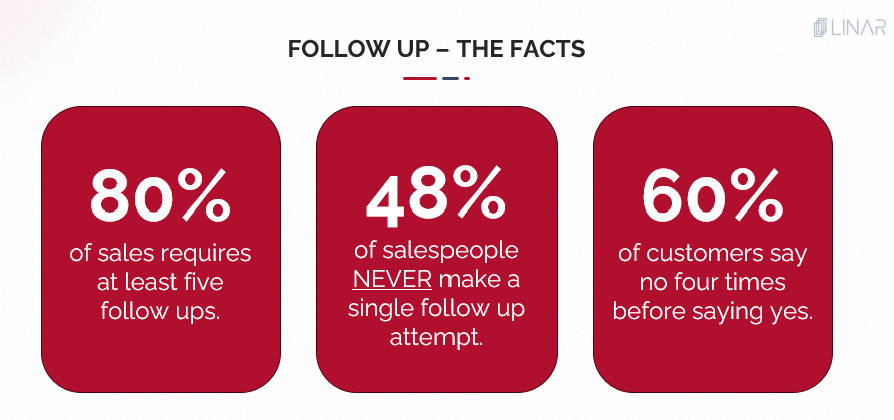Conversion
So here we are. The last mile. Over the past few weeks, we’ve defied overwhelming odds and now have a potential customer within sniffing distance of the line. The proposal last week has landed well BUT, there is still work to do. Doubts will emerge, questions will be frustrating and relentless and there will always be haggling over the price. Remember, until there’s a signed contract, take nothing for granted.
Welcome to the final week of deconstructing the sales cycle. Stay calm, stay cool and enjoy the adrenaline that comes with the all important conversion stage. Here’s our Three top tips for victory.
#1. Perseverance
It’s hard work to get a customer to part with their money. Doubt and indecision are a seller’s nightmare, creating undue delays in an already long process. And, whilst this sale might be a big deal to you, it’s likely to be one of a hundred other things on your customer’s desk. Maintaining momentum during the conversion process is essential to securing that sale. Our tips for staying front of mind include:
- Follow up, follow up, follow up: regularly check in with prospects without being overly persistent. You’ve earned the right to know the outcome of your work nurturing this opportunity, so be relentless in your pursuit of an answer. Use your CRM/Outlook/PA to remind you to nudge your prospect on a frequent (we recommend weekly) basis. This will help you to stay front of mind and also demonstrate your desire to win the job.
- Provide ongoing value: in a sophisticated buying market, repetitive, one dimensional follow ups will not achieve your outcome. Look to share relevant content, insights, or updates that keep the conversation alive and demonstrate your ongoing commitment to helping the customer.
- Stay positive and persistent: maintain a positive attitude and keep the communication lines open. Sometimes, customers need more time to decide, and your continued interest can tip the scale in your favour. As the stats below prove, perseverance will keep you ahead of the competition.

#2. Objection handling
It’s entirely natural for the person(s) on the other side of the deal to get nervous pre-sale. They will have to justify the cost of purchase to their bosses and will remain responsible for delivering the benefits promised way after you disappear into the sunset.
Successfully navigating objections is crucial in the conversion stage. Anticipate common concerns and prepare clear, confident responses. Understand the customer’s needs and pain points to address objections effectively. The following techniques work for us:
- Patience: spending time with a customer can be very powerful in unlocking some of the barriers to purchase. Offer to go and see the customer at their office (or home if working remotely) and workshop their concerns with them. Your aim here is to make more effort than the competition and show the customer that you care.
- Evidence and testimonials: use case studies and testimonials to provide social proof. Encourage them to re-engage with the referral contacts you provided at the opportunity stage.
- Be open to alternatives: some objections may require flexibility on your side to resolve. Keep the bigger picture in mind and, to the extent that you can provide alternatives that do not materially change the core commercial components of your proposition, work with your customer to find a shared solution.
#3. Negotiating a win/Win Position
Negotiation is about finding a mutually beneficial agreement where both parties feel they are getting value from the transaction. Here are some key strategies to try:
- Know your bottom line: it is your customer’s right to haggle and try and achieve the best price for their organisation. When preparing to negotiate, understand your bottom line and hold firm. DO NOT reduce your offer without first de-scoping or taking something off the table. Be open to discussion but also be prepared to walk away if the right deal cannot be reached. This is really hard to do but will pay dividends down the line as it creates integrity for your organisation’s pricing structures.
- Provide options & alternatives: last week we discussed creating multiple options for your customer to increase your probability of a win. The same goes during the negotiation phase. Understand your customer’s challenges and tailor your solution accordingly. Some common examples include:
- Allow milestone/staged payments instead of payment upfront.
- Offer a money back guarantee if the customer is not satisfied with the services provided.
- Link your compensation to results. This demonstrates to the customer that you have skin in the game and are confident in your/your organisation’s abilities to deliver.
We hope you’ve enjoyed this sales deconstruction mini-series of Three Things. Feedback is a gift – we’d love to hear yours via this 2 min survey link.
Over the next few weeks we’ll be inviting some of our key industry colleagues operating in complementary and associated areas to share with us their thoughts on their chosen area of speciality.





